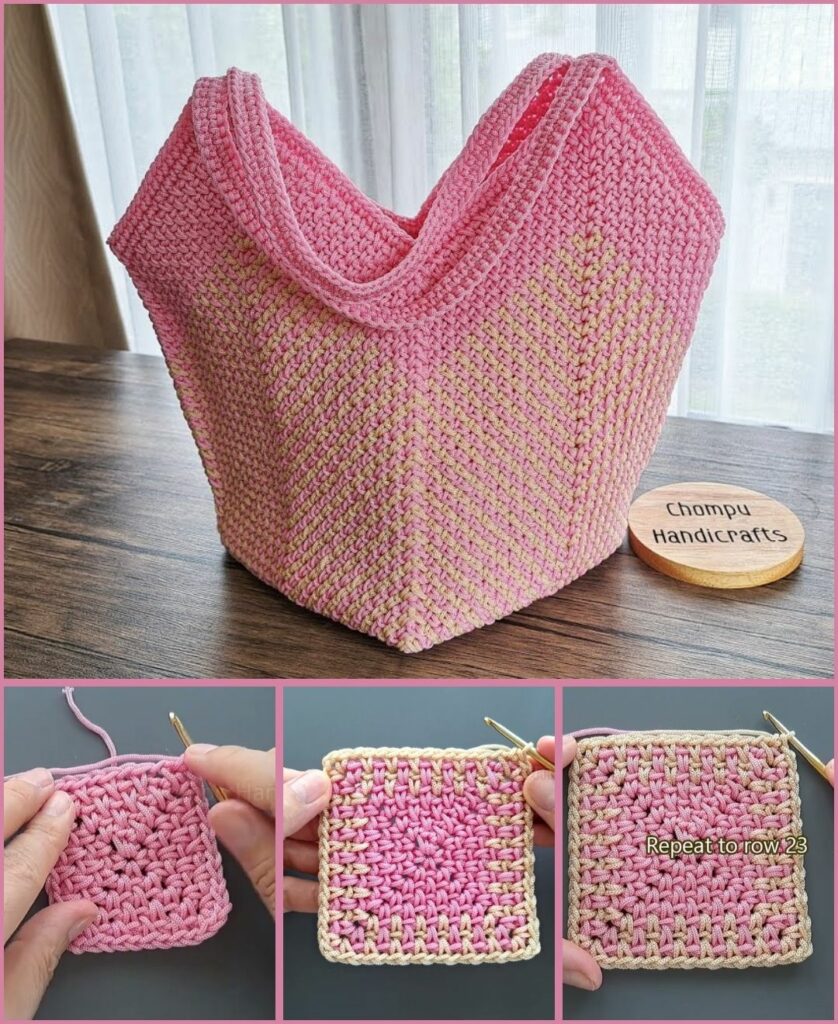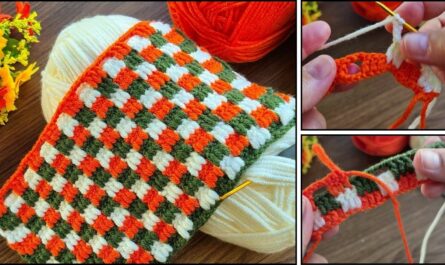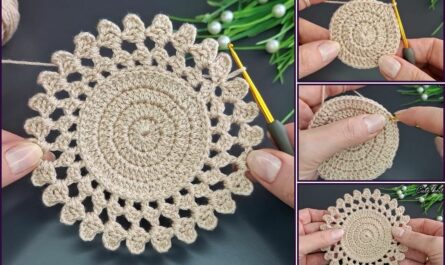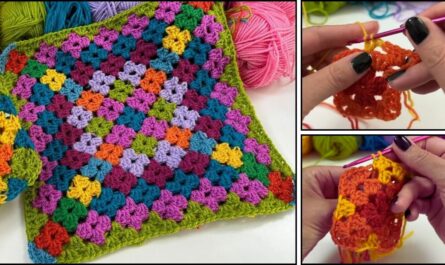Making a crochet granny square handbag is a classic and incredibly rewarding project! It allows for endless creativity with color combinations and results in a charming, often nostalgic accessory. It’s also a fantastic way to use up yarn scraps.
Given that you’re in Phnom Penh, where the climate can be warm, using 100% cotton yarn or a cotton blend is highly recommended for your bag. Cotton is breathable, durable, holds its shape well, and is easy to wash, which are all great qualities for a practical handbag.

How to Crochet a Granny Square Handbag
This tutorial will guide you through creating a beautiful and functional handbag made from granny squares. We’ll focus on a design that uses individual squares seamed together, which offers a sturdy structure and classic look.
1. Essential Materials You’ll Need
- Yarn:
- Fiber: 100% Cotton or a Cotton Blend (e.g., 80% Cotton / 20% Acrylic). These materials are durable, have minimal stretch, and show off the granny stitch definition beautifully. Avoid 100% acrylic if you want a very rigid bag, as it can stretch more easily under weight.
- Weight: Worsted Weight (Aran / Medium / 4) is ideal. It works up at a good pace and creates a sturdy fabric.
- Colors: Get creative! You’ll need at least two colors (one for the center and one for the outer rounds of each square, or change colors every round). You can use many more for a truly scrappy, vibrant look.
- Quantity: For a medium-sized handbag (approx. 10-12 inches tall, 12-14 inches wide), you’ll need about 500-700 yards (450-640 meters) total. This amount will be distributed among your chosen colors.
- Crochet Hook: A 4.0mm (US G/6) or 4.5mm (US 7) hook. The key is to achieve a consistent tension that creates a fabric firm enough to hold the bag’s shape without being too stiff. If your stitches feel loose, go down a hook size.
- Scissors: For cutting yarn.
- Yarn Needle (Tapestry Needle): Absolutely essential for weaving in all those ends and, most importantly, for seaming your granny squares together.
- Stitch Markers (Optional but Recommended): Helpful for marking corners or the beginning of rounds, especially for your first few squares.
- Optional: Fabric lining (for extra durability, to prevent small items from slipping through stitches, and for a more polished interior), magnetic snap closure or a button, and D-rings for attaching strap if not integrated.

2. Basic Crochet Stitches You’ll Use
This project relies on just a few fundamental crochet stitches, making it very accessible:
- Chain (ch): To begin your work and create chain spaces.
- Slip Stitch (sl st): Used for joining rounds.
- Double Crochet (dc): The main stitch that forms the “granny” clusters.
- Magic Ring (MR): (Also known as Magic Circle). This is the best way to start the center of your granny square for a tight, hole-free start. Alternatively, you can use
ch 4, sl st to first ch to form a ring.
Part 1: Crocheting the Granny Squares
The core of this bag is the classic granny square. You’ll make several of these, depending on the size and shape of your desired bag.
Abbreviations (US Crochet Terms):
- ch: chain
- sl st: slip stitch
- dc: double crochet
- st(s): stitch(es)
- sp: space
- MR: magic ring
Instructions for One Granny Square:
- Start (Color A): Create a Magic Ring (MR).
- Round 1: Ch 3 (counts as 1 dc). Work 2 dc into MR. *Ch 3, 3 dc into MR*. Repeat from * to * 2 more times. Ch 3. Join with a sl st to the top of the starting Ch 3. (4 clusters of 3 dc, 4 ch-3 spaces)
- This directly sets up your 4 corners.
- Change to Color B on the last sl st if desired. To change colors cleanly: on the very last sl st, don’t yarn over with Color A to pull through. Instead, pick up Color B, yarn over with Color B, and pull it through to complete the sl st.
- Round 2 (Color B or same color): Sl st into the first ch-3 sp. Ch 3 (counts as 1 dc). Work (2 dc, ch 3, 3 dc) into the same ch-3 sp (this is your first corner).
- *Ch 1, skip 3 dc. Work (3 dc, ch 3, 3 dc) into the next ch-3 sp (this is your next corner).*
- Repeat from * to * 2 more times. Ch 1, skip 3 dc. Join with a sl st to the top of the starting Ch 3. (8 clusters of 3 dc, 4 ch-3 sps, 4 ch-1 sps)
- Change to Color C on the last sl st if desired.
- Round 3 (Color C or new color): Sl st into the first ch-3 sp. Ch 3 (counts as 1 dc). Work (2 dc, ch 3, 3 dc) into the same ch-3 sp.
- *Ch 1, 3 dc into the next ch-1 sp. Ch 1, skip 3 dc. Work (3 dc, ch 3, 3 dc) into the next ch-3 sp.*
- Repeat from * to * 2 more times. Ch 1, 3 dc into the next ch-1 sp. Ch 1. Join with a sl st to the top of the starting Ch 3. (12 clusters of 3 dc, 4 ch-3 sps, 8 ch-1 sps)
- Change colors on the last sl st if desired.
- Round 4 and onwards: Continue the pattern, always working (3 dc, ch 3, 3 dc) into each corner ch-3 sp, and (3 dc) into each side ch-1 sp, separated by Ch 1.
- The size of your granny square will determine the size of your bag. For a medium handbag, squares that are about 6-8 inches (15-20 cm) across (likely 4-6 rounds) work well.
- Number of Squares: You’ll typically need 6 squares for a basic handbag: one for the front, one for the back, two for the sides, and two for the bottom.
Fasten Off: Once your square reaches the desired size, fasten off your yarn, leaving a tail of about 6-8 inches (15-20 cm).

Part 2: Planning Your Bag Layout & Making Enough Squares
For a standard rectangular granny square handbag, you’ll arrange your squares like this:
TOP OPENING
_________________
| | |
| FRONT | BACK |
|________|________|
| | |
| SIDE | SIDE |
|________|________|
| | |
| BOTTOM | BOTTOM | (These can be two squares or one large rectangle)
|________|________|
A common layout for a rectangular bag involves:
- 4 squares for the main body (2 for the front/back, 2 for the sides).
- 2 squares for the bottom. (Alternatively, you can make one long rectangle by seaming two squares together for the base, then attaching it).
So, for a sturdy rectangular bag, plan to make at least 6 identical granny squares (or 4 squares and a rectangular base).

Part 3: Assembling Your Granny Squares
This is where your bag starts to take shape!
- Weave in All Initial Ends: Before seaming, use your yarn needle to weave in all the starting tails from your Magic Rings and any tails from color changes within each square. Weave them in thoroughly to prevent unraveling.
- Seaming Technique: The neatest and strongest way to join granny squares is often with a whip stitch or mattress stitch using a yarn needle, or a slip stitch join or single crochet join (which creates a subtle ridge). For a handbag, strength is important, so a whip stitch or single crochet join is usually preferred.
- Whip Stitch (Yarn Needle): Lay two squares flat with their wrong sides facing each other (or right sides facing each other if you want the seam on the outside). Thread your yarn needle with a long tail of yarn (can be a matching or contrasting color). Pass the needle through both loops of the corresponding stitches on each square, from one edge to the other, creating a clean, tight seam.
- Layout and Seam:
- Arrange your squares in the desired layout (e.g., a long strip of four squares for the body, and two for the bottom, or just two rows of three squares).
- Seam the Body: Start by seaming two squares together side-by-side. Then add another, and another, until you have your full body section (e.g., four squares in a row).
- Seam the Bottom: Seam your bottom squares/rectangle to the bottom edge of your body section.
- Form the Bag: Fold the piece so the two end squares meet, and seam those edges together to form the tubular shape of the bag.
- Close the Sides: If your bottom is separate, now seam the sides of the bottom squares to the corresponding bottom edges of your side squares.

Part 4: Shaping the Top Edge & Adding the Handles
Once your bag body is assembled, you’ll finish the top edge and add the handles.
Option A: Integrated Handles (More secure, seamless look)
- Top Edge Finishing (Using a main color or accent color): Join yarn with a sl st to any stitch at the top opening of your bag.
- Round 1 (Top Edge Prep): Ch 1 (does not count as st). Work 1 sc in each dc and 1 sc in each ch-1 sp around the entire top opening of the bag. When you reach a ch-3 sp at a corner, work 3 sc into it to turn the corner neatly. Join with a sl st to the first sc. (Count your stitches! This round will solidify the top edge and standardize the stitch count for handle placement).
- Round 2 (Handle Creation): Ch 1. Sc in the first few stitches (e.g., 8-12 stitches, adjust to center your handle).
- Ch 40-50 (This forms your first handle loop. Adjust this chain length for your desired handle drop – hold it up and test it out!).
- Sk the next 15-20 stitches on the bag top (this creates your handle opening).
- Sc across the next section of stitches (this is the top middle of the bag, between the handles).
- Ch 40-50 (second handle).
- Sk the next 15-20 stitches.
- Sc in the remaining stitches. Join with sl st.
- Round 3 (Handle Reinforcement): Ch 1. Work 1 sc in each sc around the bag opening. When you reach a chain-loop handle, work sc stitches evenly into the chain loop (e.g., 1 sc per chain, or slightly more if needed to keep it flat). Continue working sc stitches on the bag body and the second handle. Join with sl st.
- Repeat Round 3 one or two more times for extra thick, sturdy, and comfortable handles.
- Fasten Off and weave in all ends securely.
Option B: Separate Strap Handles (Allows for hardware or different materials)
- Top Edge Finishing: Work 2-3 rounds of sc stitches (Ch 1, 1 sc in each st around, join with sl st) around the entire top opening of your bag. Fasten off and weave in ends. This creates a neat, sturdy top edge.
- Crochet Separate Straps:
- Strap Pattern: Ch 6 (adjust for desired strap width).
- Row 1: Sc in 2nd ch from hook and across. (5 sc)
- Rows 2-X: Ch 1, turn. Sc across. Repeat until strap is your desired length (e.g., 20-30 inches / 50-75 cm).
- Make two identical straps. Fasten off, leaving long tails for sewing.
- Attach Straps: Using your yarn needle, securely sew the ends of the straps to the inside of the bag’s top opening. Position them symmetrically on the front and back of the bag. Stitch multiple times to ensure extreme durability.

5. Finishing Your Bag
- Weave in ALL Remaining Ends: This is the absolute most critical step for a professional-looking and durable bag. Take your time to weave in all yarn tails from color changes and seams securely into the fabric, preferably on the inside of your bag. Loose ends will quickly unravel, especially with a bag that gets daily use!
- Blocking (Recommended): While cotton bags hold their shape reasonably well, blocking can truly elevate your finished product.
- Gently wet your entire bag.
- Carefully squeeze out excess water (do not wring!).
- Stuff the bag with towels or newspaper to help it hold its shape. Lay it flat or stand it upright (if it can).
- Allow it to air dry completely. Blocking will help even out your stitches, flatten your squares, and make your bag look perfectly shaped.
- Optional Lining: For added durability, structure, and to prevent small items from slipping through the granny stitches (which can be a bit open), sew a fabric lining into your crochet bag. This is highly recommended for any functional handbag. You can hand-sew it in using a regular needle and thread.
- Optional Closure: Add a magnetic snap closure, a button with a crochet loop, or a zipper to the inside of the bag for security.
You’ve now got a detailed guide to create a fantastic, unique, and functional granny square handbag! Enjoy the creative process and showing off your beautiful handmade creation.



